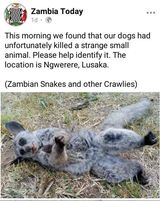

By Jemimah Chungu
On the top is different types of lemurs available on different spaces of the internet. On the bottom is a Facebook post by Zambia Today sourced from Zambia snakes and crawlies.
The saga began mid this year (2023) a Zambian animal conservation group shared on social media that what they described as a strange animal was unfortunately killed by dogs but they could not identify it. “This morning we found that our dogs had unfortunately killed a strange small animal. Please help identify it. The location is Ngwerere, lunch”.

I can’t help but spot the indisputably similarities between lemurs and the said strange animal.
Lemurs are unique group of primates indigenous to Madagascar, an Island off the coast of southern- eastern Africa. Lemurs are the third of the only primates in existence, the other two primates are monkeys and apes. However they make up a separate branch of the primate family tree and are classified as a superfamily, made up of five individual lemur families and more than 100 species (Live Science).
The name lemurs/ lemur is derived from a Latin word called ghosts or spirits. Lemurs were given this name by scientists because they viewed them as ghosts in trees given their large eyes as well as they hibernation and arboreal nature. If they are like ghosts/ spirits, could have the aforementioned, strange animal found in Zambia executed some ghosts’ behavior and found in Zambia if it is a lemurs.
Lemurs are given a general description and identified by their fat tails, pointy- wet nose, fat long tails, soft fur, bright round eyes. These may differ in color depending on the specie and gender. Most common colors are white grey, black brown, red-brown with different prints and patches. The strange animal in Lusaka matches the general looks of lemur as seen in the picture attached.
Lemurs are endangered. The cause of endangering lemurs species is based mostly on loss of habitat, where they hibernate as well most of the time and source food all of the time. But environmental degradation at large such as pollution contribute to the endangering of these species. Even though they’re threatened, the largest population of lemurs are in Madagascar whereas some are existing in other parts of the world. Lemurs are known to hibernate in almost the entire year and live on land for only a quarter of the year. They hibernate in the woodlands of the western coast of Madagascar.
This strange lemur’s look alike was found in Zambia which is in the same geographical region as the native country to Madagascar. They are native to Madagascar probably because of the climate, geographic location, the natural landscape including woodlands and coastal Landshut, Food (fauna and flora) and other environmental goods and services friendly to them.
Zambia on the other hand is not a coastal nation but is in the same geographical region as Madagascar sharing the same resources such as aquatic resources- Indian Ocean and have similar woodlands that start from Tanzania and Mozambique, neighboring countries to both Madagascar and Zambia. For example the African international identified a genus of a bamboo tree that is found in only One Island within Zambia but is abundant in Madagascar probably found in Tanzania too.
Therefore the woodlands that accommodate in Madagascar are quite similar to that in Zambia and could probably habit them too (but maybe a very small population existing in Zambia to the point that it is unlikely to recognize and spot them at all.) Lemurs are also known to hibernate almost the entire year and live on land only one quarter of a year therefore lemurs predictable or assumed to be a very small population in Zambia could be hard to spot. Or find or notice or seen.
Zambia have some intense woodlands that have not been fully explored. Some of these are actually assiduous in Tanzania a neighbor to both Zambia and Madagascar For example the escarpments. Therefore the fauna these woodlands habits are also unexplored perhaps lemurs maybe habiting in them unidentified, or just unseen or maybe the population too small to be recognized.
Besides according to live science there are more than 100 species of lemurs, this strange animal could be among the many species of in a different undiscovered habitat. Similarly, the natural environmental structure and ecosystem has been degraded thereby restricting the original natural set-up. This situation could entail that lemurs among many other fauna extend their natural habitat to adapt to degraded environments.
Lemurs are unable to swim especially in deep waters like the Indian Ocean according the knowledge known to humans but the National Geographic declares that some tiny neighboring islands are able to habit Lemurs due to the geographic isolation. This is because lemurs may have floated there on “rafts” of vegetation and evolved in isolation over countless centuries.
Without doubt species of lemurs such as the mongoose habit in the islands of Comoros and Mauritius possibly with the explanation by National Geographic or are indigenous habitat. However if they indeed floated there, some lemurs species possibly floated to the wild/ woodlands of Tanzania, and Mozambique that are joined to those in Zambia and possibly how this lemurs or strange animal landed Zambia.
On the other hand, in the world that has rampant animal trafficking, this strange animal could be a fugitive of trafficked lemur in Zambia. Perhaps it is just a similar animal considering there are no records of lemur in Zambia, however considering the similarities, could the said strange animal be an unknown 4th primate or just a resembling creature to a primate?
The strange animal was unfortunately killed by dogs and probably still unidentified but I hope this is a lemur and there are many more of these endangered species habiting in Tanzania, Mozambique and Zambia.

